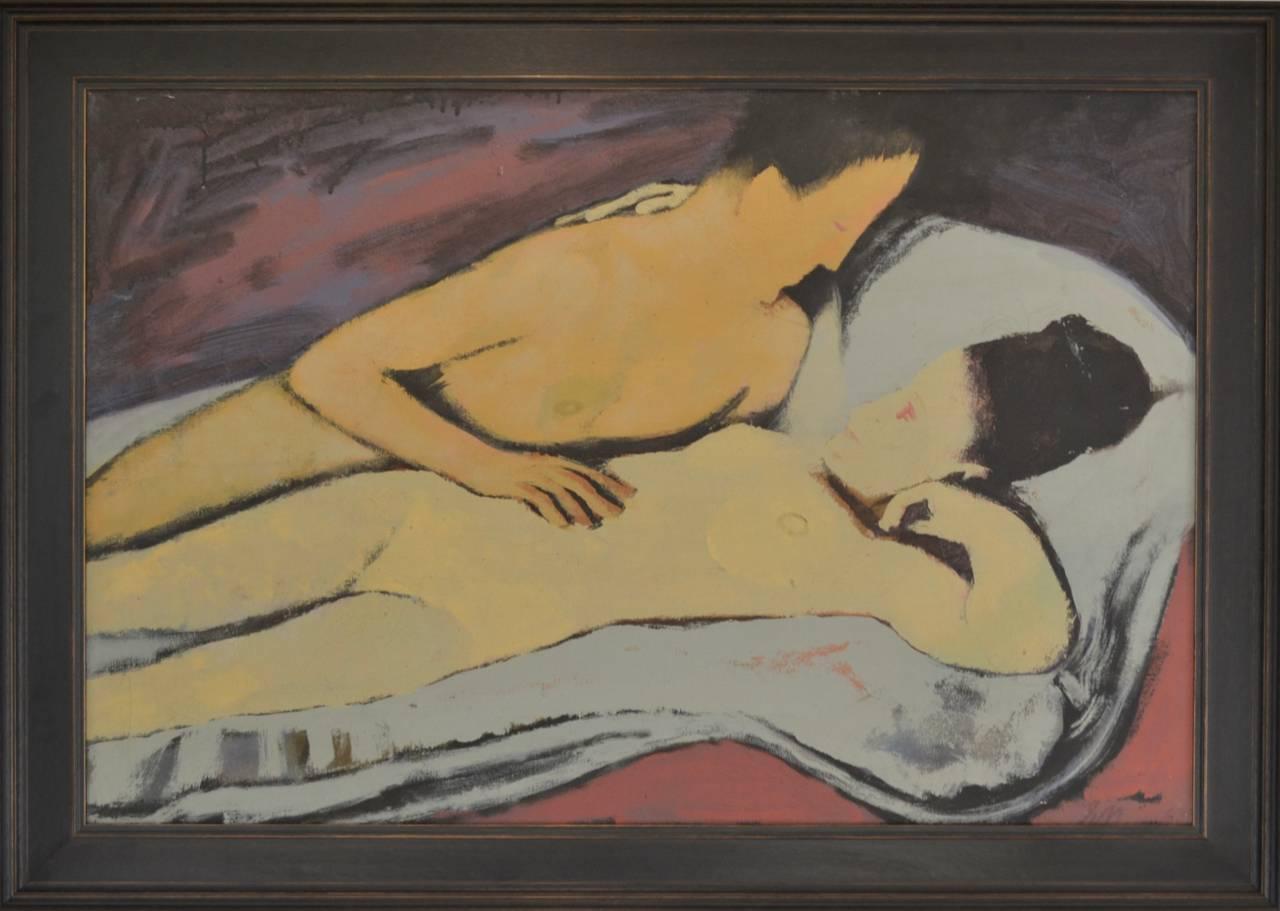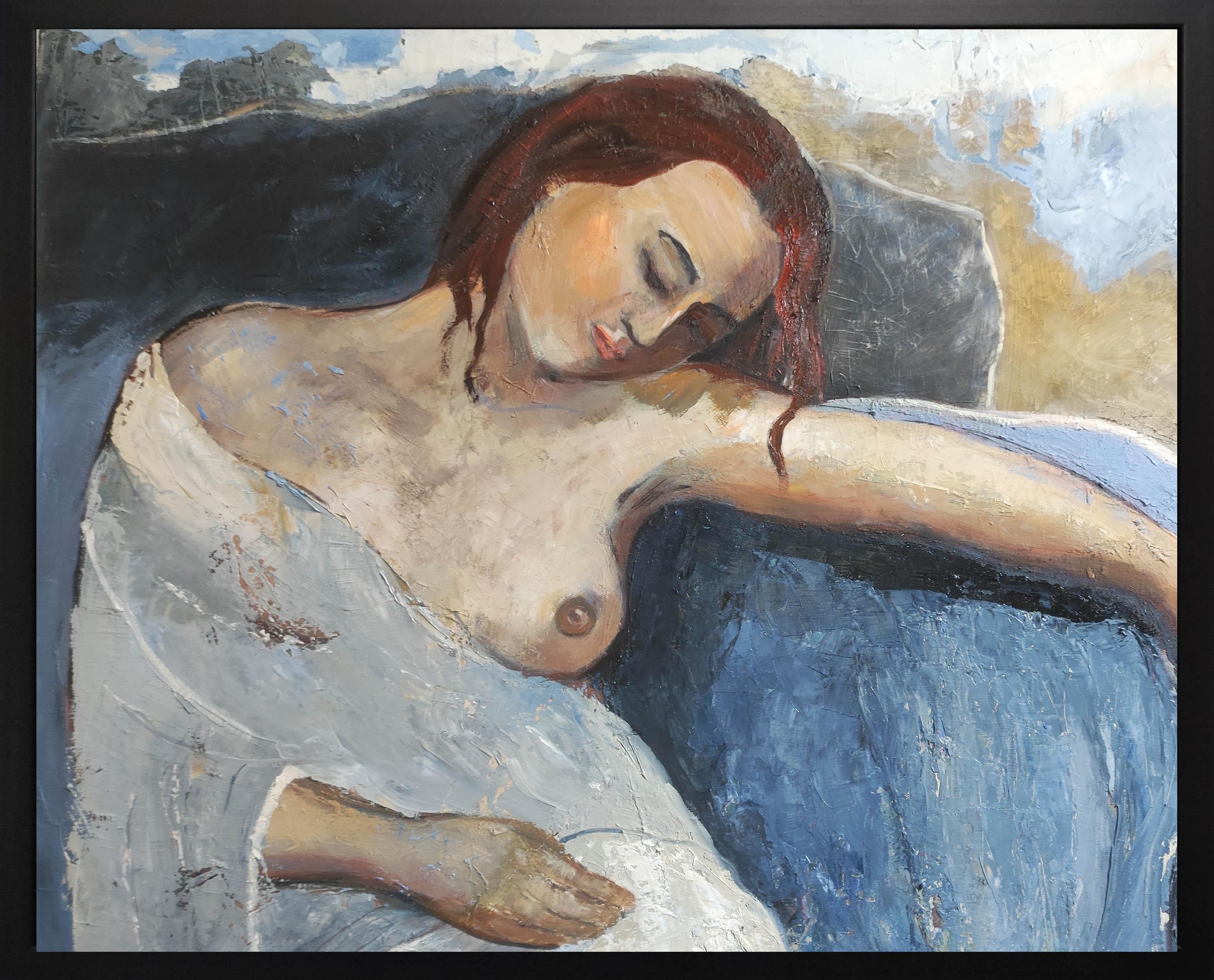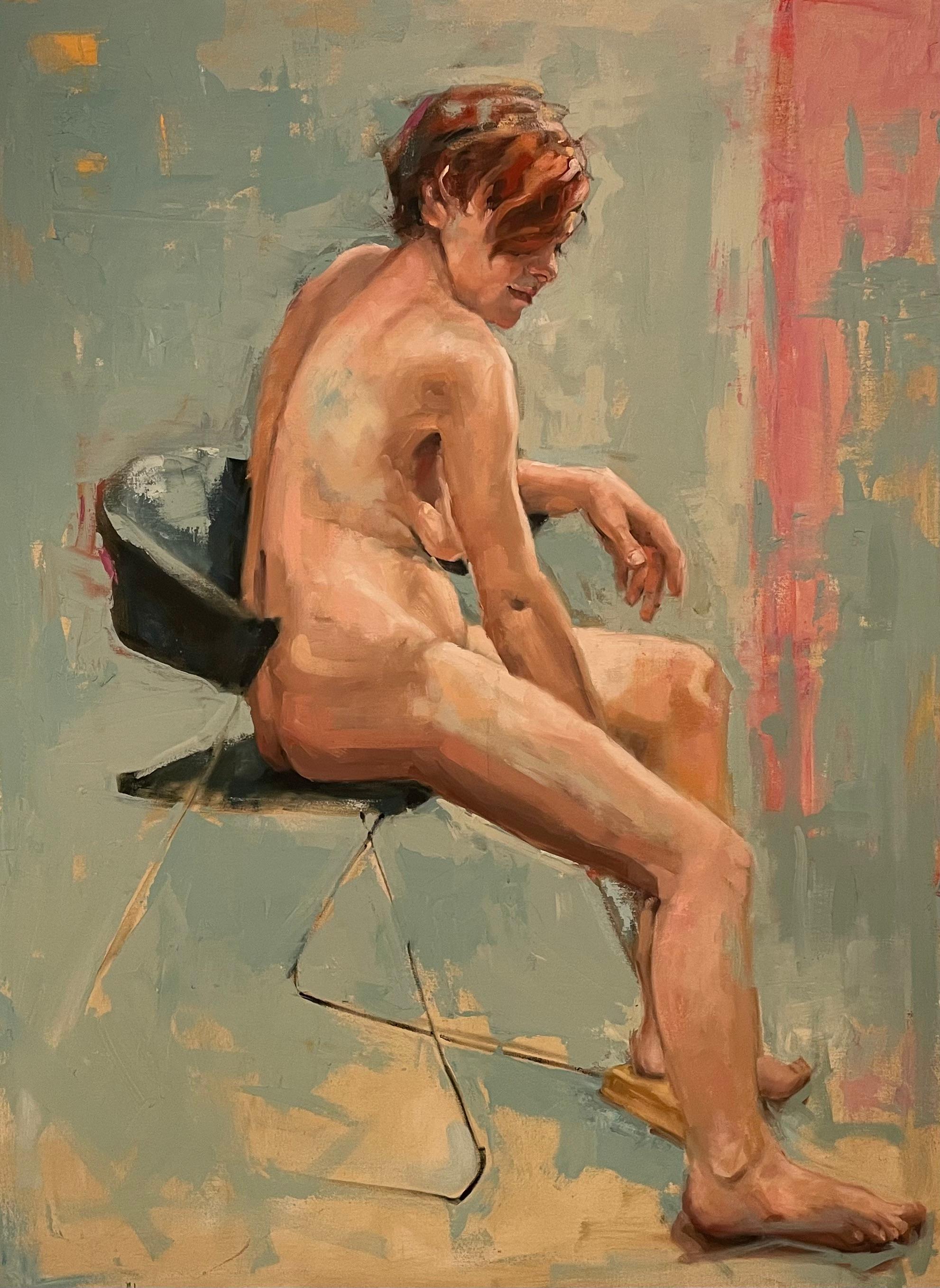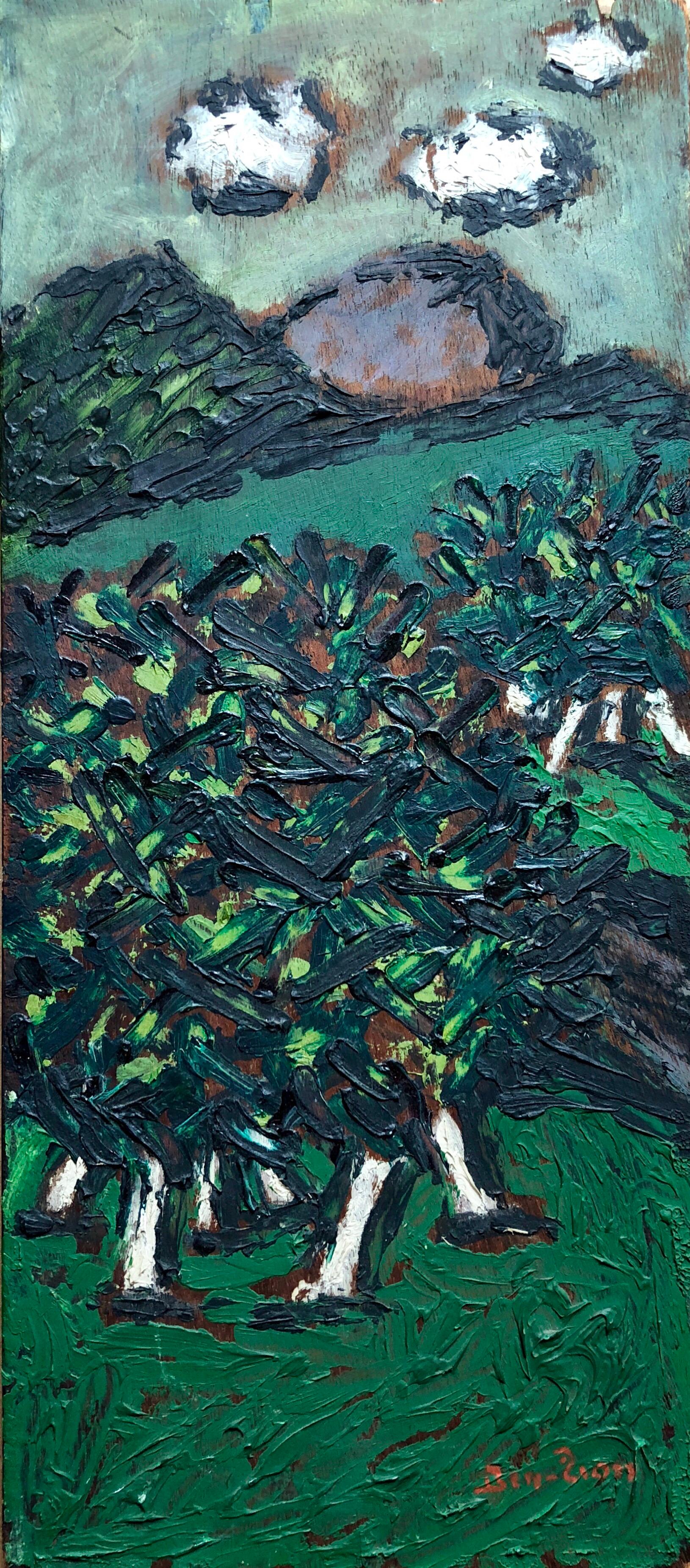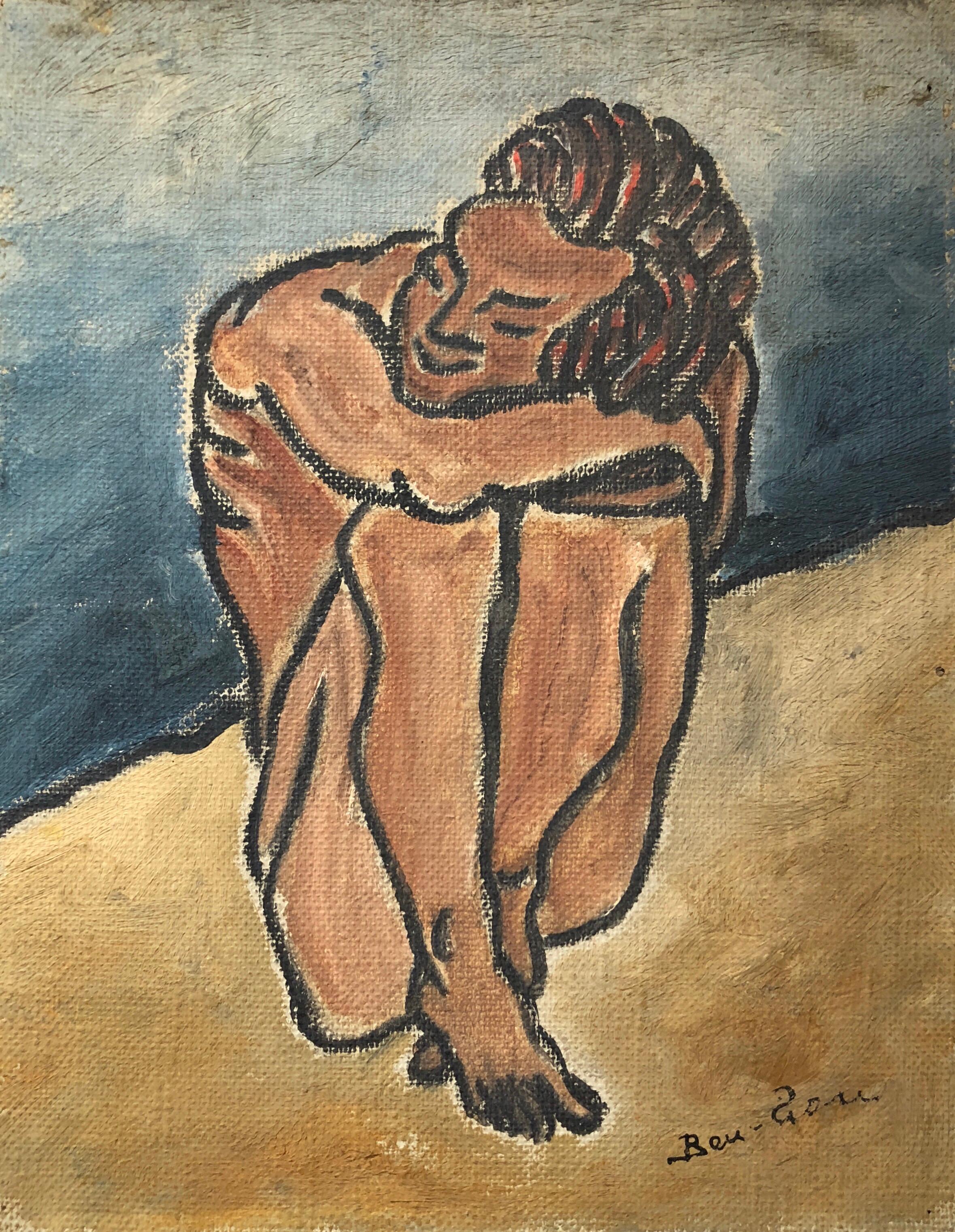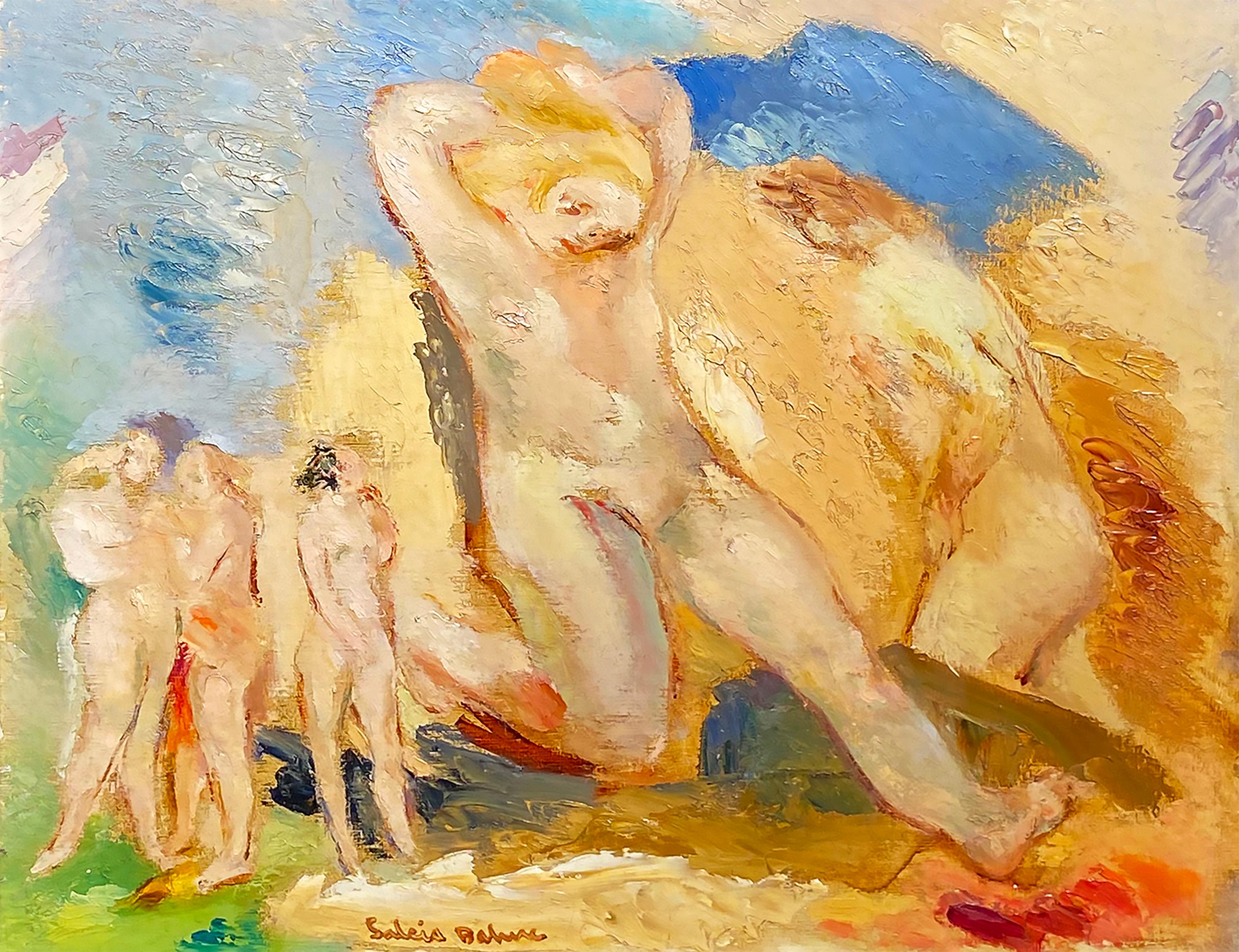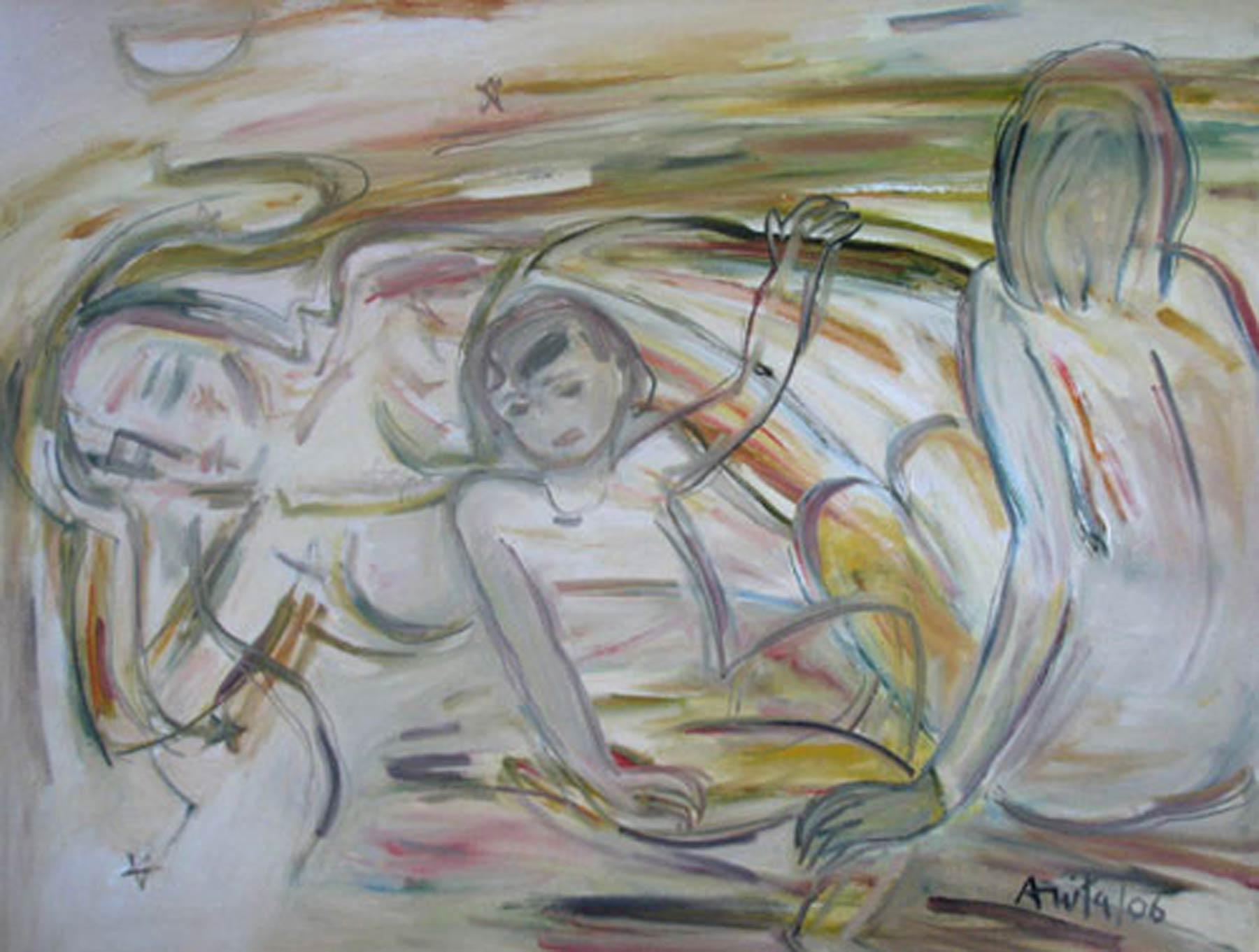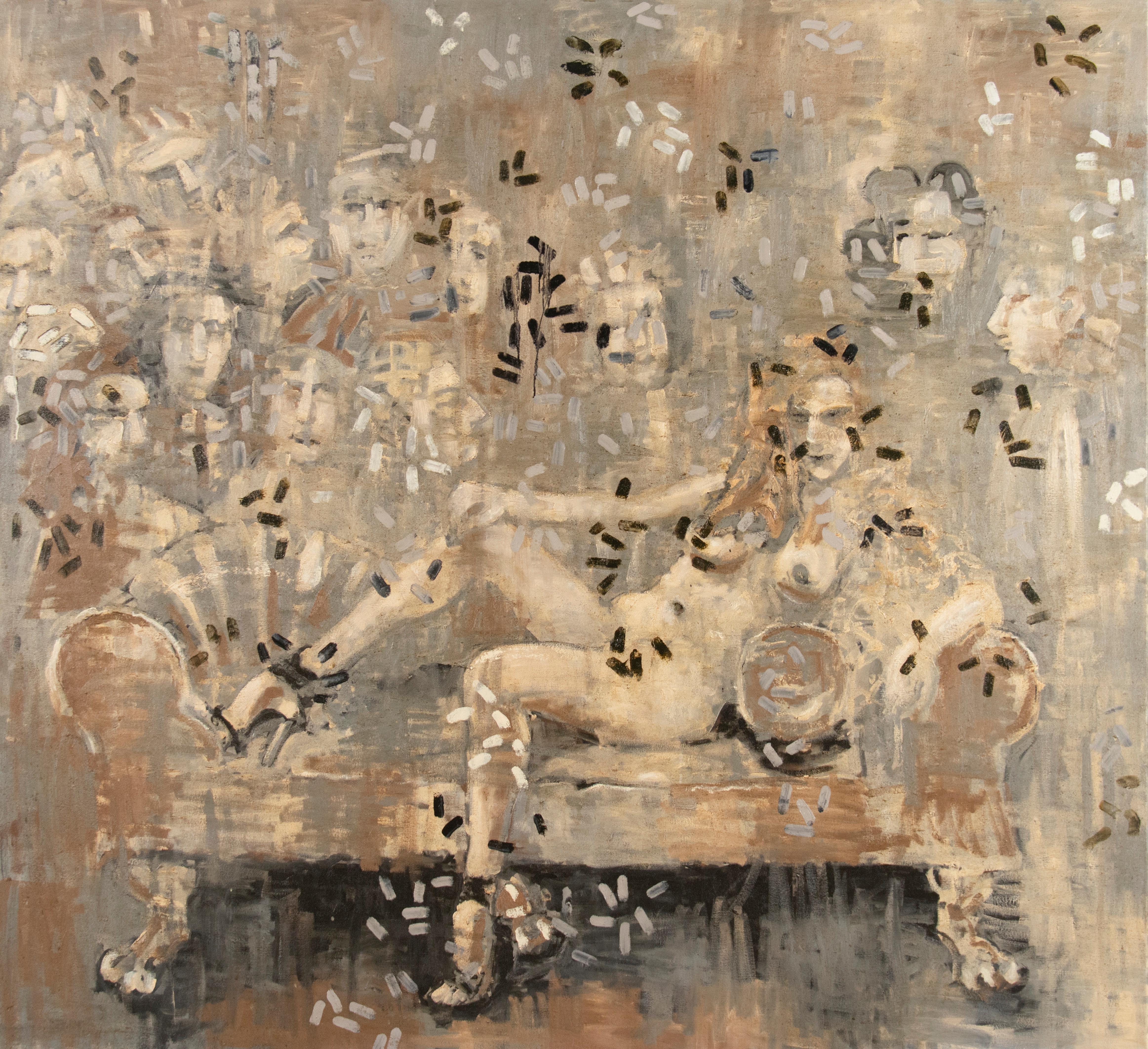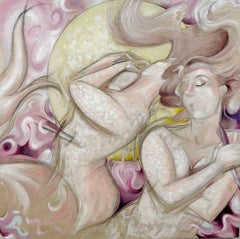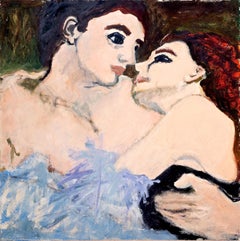
After the Ball
View Similar Items
Betsy PodlachAfter the Ball2015
2015
About the Item
Artist Comments
I love fabric and clothing. I like to create clothes in painting because I am not a fashion designer in life. I find relationships, like most people do, fascinating, and romantic ones especially. I often paint couples, nude and clothed in various moments of the the life I imagine them in.
About the Artist
As a student, Betsy received a scholarship to study visual art at Harvard, a feat she describes as key to her progression as an artist. Betsy’s portraits exude emotion through the expressive eyes of her figures. Looking down, just past the viewer, or at a partner, each gaze offers an understanding of the subject’s psychological state. Primarily painting from life, Betsy focuses on the intersection of the physical, emotional, and intellectual characteristics both of her subjects and within herself. “I love stories and novels, poetry and plays–I hope my work comes alive, tells a story, and does so in a way that stops time, in a permanent image.”
After the Ball
Betsy Podlach
Oil painting on stretched linen
Finished white edges
Ready to hang
One-of-a-kind
Signed on back
2015
38 in. h x 38 in. w x 1.5 in. d
25 lbs. 0 oz.
- Creator:Betsy Podlach (1964, American)
- Creation Year:2015
- Dimensions:Height: 38 in (96.52 cm)Width: 38 in (96.52 cm)Depth: 1.5 in (3.81 cm)
- Medium:
- Movement & Style:
- Period:
- Condition:After the Ball. Betsy Podlach. Oil painting on stretched linen. Finished white edges. Ready to hang. One-of-a-kind. Signed on back.
- Gallery Location:San Francisco, CA
- Reference Number:Seller: 590771stDibs: LU92213178581
- Queen of the Selkies, Oil PaintingBy Sumner CrenshawLocated in San Francisco, CA
Artist Comments
Inspired by a Scottish folktale during her trip to Scotland, artist Sumner Crenshaw depicts two figures under the moon. In the tale, a selkie transforms into a ...Category21st Century and Contemporary Expressionist More Art
MaterialsOil
- Back Bend, Oil PaintingBy Sumner CrenshawLocated in San Francisco, CA
Artist Comments
A nude woman strikes a seductive pose, her hair hanging gracefully in sweeping curves. Created with oil paint and graphite, the piece started as an experiment f...Category21st Century and Contemporary Expressionist More Art
MaterialsOil
- KatBy Patrick SoperLocated in San Francisco, CA
Artist Comments
This is a heavy, impasto work done with palette knife and oil. It is both a celebration of texture and color in an attempt to bring vibrancy to the figure. Pa...Category21st Century and Contemporary Expressionist More Art
MaterialsOil
$2,300 - Body, Oil PaintingLocated in San Francisco, CA
Artist Comments
In this piece, artist Matson Ambroise features the female nude torso, set within a textured, abstract space. The proximity betwee...Category21st Century and Contemporary Contemporary Nude Paintings
MaterialsOil
- Free, Oil PaintingLocated in San Francisco, CA
Artist Comments
Artist Matson Ambroise creates art that exists as two things at once, fiercely modern yet discerningly timeless. In this particular piece, Matson depicts a bold and intriguing portrait of a cowgirl set...Category21st Century and Contemporary Contemporary Nude Paintings
MaterialsOil
- Bathed in the Spotlight, Oil PaintingBy Sumner CrenshawLocated in San Francisco, CA
Artist Comments
"A confident Curly Girl struts across the stage, channeling her inner Betty Boop," Sumner explains. "She flashes a playful tattoo as she moves across the floor, pictured here as stripes of black and lemon yellow, while the limelight curves around her. She is all about putting the fun in femininity." This painting is part of Sumner's signature series of Curly Girls. These flowing, Art Nouveau-inspired characters represent transformation. Sumner always places the figure alone and in the middle of a personal story - in the middle of their transformation.About the Artist
Sumner Crenshaw infuses her work with movement, lines and varying degrees of color. She currently lives in Maryland and finds inspiration in the work of Salvador Dali. Her goal is to keep exploring the minimalist, narrative surrealism she's been moving toward.Words that describe this painting: figurative, nude, feminism, playful, fun, cartoon, art nouveau , nudes, representational, oil painting, white
Bathed in the Spotlight...
Category21st Century and Contemporary Nude Paintings
MaterialsOil
- In The Room #4 by Katya Tsareva - Expressionist painting, oil on canvas, 2021Located in Basel, BSThe Room #4 is the 4th work in "In The Room" series by contemporary artist Katya Tsareva. In this series the artist continues to analyze the difficult re...Category
2010s Expressionist Nude Paintings
MaterialsOil, Canvas
- Seated NudeBy Helge HelmeLocated in New York, NYAxel Henry Helge Helme (1894 Roskilde, Denmark 1987), Seated Nude, circa 1930, oil on canvas, original frame Son of a merchant, Helge Helme was admitted ...Category
20th Century Expressionist Nude Paintings
MaterialsOil, Canvas
Price Upon Request - "Aquarius" Oil Painting 31.5" x 51" inch by Sergey DolmatovLocated in Culver City, CA"Aquarius" Oil Painting 31.5" x 51" inch by Sergey Dolmatov Year: 2014Category
21st Century and Contemporary Expressionist Figurative Paintings
MaterialsCanvas, Oil
- Nandor Vagh Weinmann, Oil on cardboard, Naked Back, 1930sLocated in Saint Amans des cots, FROil on cardboard by Nandor VAGH WEINMANN (1897-1978), France, 1930s. Naked back. With frame: 64x56 cm - 25.2x22 inches ; without frame: 46x38cm - 18.1x15 inches. 8F format. Signed "Nandor V. Weinmann" lower left. In its Montparnasse frame. Very good condition. Born October 3, 1897 in Budapest, Nándor is the older brother of Elemer and Maurice Vagh-Weinmann. He came to Paris to present his work in 1931. He died on December 12, 1978 near Montereau (Seine-et-Marne) following an automobile accident. He is the most colorful of the three “expressionist” brothers. Painter of figures, landscapes, especially open mountains, and bouquets in bright colors. He is also a religious painter and then finds the tragic condition. Born in BUDAPEST on October 3, 1897, Nandor Vagh Weinmann belongs to a profoundly artistic people. Living in the heart of Central Europe where they came from Asia a millennium ago, the Hungarians have preserved a strong ethnic individuality whose mark is their very synthetic, non-Indo-European language. Resistant to secular invasions, they have kept the virtues of a very ancient humanity that have become rare in our modern world, especially since their way of life has remained essentially rural until today. In the arts they know how to express a generous, extreme sensibility and by the poetic verb, by the musical rhythms and also by a popular art of a richness, an exceptional harmony. Until the age of thirty-four, during the decisive years of childhood and youth, Nandor Vagh Weinmann was intimately imbued with popular life and the soul of Hungary. From the capital where his father was a jeweler and had a family of ten children, Nandor was the fifth, he knew first of all the suburbs, the populated districts, the rigors in winter of the cold and the snow. A very mobile existence made him acquainted with all of Hungary, from the Danube to Transylvania, its infinite plains and its wild mountains, its immense villages with ample low houses, and its towns which are still immense villages. The painter is passionate about rustic works, harvest scenes, beautiful folk costumes. Coming into direct contact with the peasants, he learned to know their soul. These contacts gave the artist a direct feeling for popular life and soul, as Millet once understood the peasants of Barbizon and Normandy whose existence he shared. What fascinated Nandor Vagh Weinmann above all were the festivals which enlivened the dreary life of the countryside, the circuses, the merry-go-rounds, the gypsies unleashing orgies of music, light and color. In the party, and especially the Hungarian party, the whole soul of a people, all its energy, its need for movement, for intensity, is expressed in its pure state and realizes the primary and essential form of what is called beauty. And as if melted at the party, there is the infinite steppe where herds of horses and oxen circulate where terrible storms sometimes roar where the seasons unfold their grandiose splendours. The young Nandor Vagh Weinmann nourishes his sensitivity to his inexhaustible shows, both eternal and always new, a sensitivity which very early declared itself that of a painter. Since the age of fourteen he painted, and since then he never stopped doing it. Two of his brothers Maurice, two years his junior, who had a remarkable career similar to that of Nandor and later Elemer who became Maurice's pupil, also devoted themselves to painting, despite family obstacles. And the three brothers united by a common passion worked together in Hungary and later in France. Painting was so much in the blood of the family, as in the past among the Veroneses, the Breughels, the Lenains, the Van Loos and so many other artistic dynasties, that three sons of the Vagh Weinmanns became painters in their turn. One of these, Emeric, son of Nandor, today occupies an important place in the contemporary school. Nandor, at fifteen, was a pupil of the Academy of Fine Arts in Budapest where he worked diligently, then at that of Vienna. He painted many portraits, but also landscapes, compositions and, by his relentless work, managed to live from his brush, although married very young and having to overcome many hardships. He therefore knew the hardships and miseries of life. These strongly impregnated his vision as an artist and explain the thrill of humanity that runs through all his work. A particularly moving experience was reserved for him at the age of twenty. In the hospitals of Budapest he had to paint extraordinary cases, operations, frightful wounds, the deformations to which our poor body is subjected by traumas and physiological decompositions. In these circumstances, it is not a question of gratuitous art, of formal research but of immediate, authentic expressions of our flesh and our being. We know that Breughel Velázquez and Goya had been haunted by the sight of cripples and of madmen Géricault by that of corpses. But life is ultimately stronger than anything, and it is life that Nandor Vagh Weinmann has passionately observed and translated through all the places where he has always painted on nature. Nothing stopped him. It happened to him to paint, for example in front of the mill of Linselles by a weather so cold, that nobody could stay outside, and that he did not leave the place before having finished his work. Because he works constantly on the ground, under the sky, in the silence he loves. His reputation is established. He exhibited at the national fair in Budapest, in the big cities of Hungary Szeged, Szombathely, Veszprém, Kaposvar. In 1931, like all artists in the world, he came to France. But unlike the others, he did not settle in Paris. Because Nandor Vagh Weinmann does not belong to this group of cosmopolitans that we call the School of Paris. He settled in Toulouse, where he remained for a long time with his brothers, and traveled throughout France, eager for new ties, exhibiting in the most diverse cities, in Bordeaux, Marseille, Lyon, Agen, Bayonne, Dax, Tarbes, Grenoble, Nice, Cannes, Strasbourg, Mulhouse, Colmar, Lille. He even crossed borders. He was in Saint Sebastian, in Geneva, and once in Egypt in 1927 where he painted King Fouad...Category
1930s Expressionist Figurative Paintings
MaterialsOil, Cardboard
- Edouard Goerg, Les 3 Brunes, Large Oil on Canvas, 1955By Edouard GoergLocated in Saint Amans des cots, FRLarge oil on canvas by Edouard GOERG (1893-1969), France, 1955. LES 3 BRUNES. With frame : 114x95cm - 44.9x37.4 inches ; without frame : 92.2x73 cm - 36.3x28.75 inches. Format 30F. S...Category
1950s Expressionist Figurative Paintings
MaterialsCanvas, Oil
- DreamLocated in Saint Amans des cots, FROil on canvas by Madé Gourdon, France, 1960s. "Dream". with frame: 70x61 cm - without frame: 55x46 cm. 10F format. Signed "Madé Gourdon" in the lower left. In its frame Montparnasse....Category
1960s Expressionist Figurative Paintings
MaterialsBurlap, Oil, Canvas
$1,200
